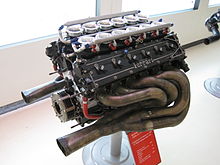Ferrari 640
This article needs additional citations for verification. (June 2018) |
mid-engine, longitudinally-mounted | |||||||||||
| Transmission | Ferrari 7-speed semi-automatic[2] | ||||||||||
|---|---|---|---|---|---|---|---|---|---|---|---|
| Power | 660 hp @ 13,000 rpm[3] | ||||||||||
| Weight | 510 kg (1,120 lb) | ||||||||||
| Fuel | Agip | ||||||||||
| Tyres | Goodyear | ||||||||||
| Competition history | |||||||||||
| Notable entrants | Scuderia Ferrari SpA | ||||||||||
| Notable drivers | 27. 28. | ||||||||||
| Debut | 1989 Brazilian Grand Prix | ||||||||||
| |||||||||||
The Ferrari 640 (also known as the Ferrari F1-89)[4] was the Formula One racing car with which the Ferrari team competed in the 1989 Formula One World Championship. It was driven by Britain's Nigel Mansell, in his first season with the team, and Austria's Gerhard Berger, winning three races between them. An early version known as the 639 is the basis of the 640 and has the same name F1-89.
Design

The car was designed by John Barnard, and it was the first Ferrari he was responsible for designing. It sported a sharp nose, with a narrow monocoque and bulging side-pods designed to house the radiators with maximum aerodynamic efficiency. It originally had two small air intakes on either side of the driver, but from the fourth race of the season in Mexico a more conventional large air intake above and behind the driver was introduced, which Ferrari kept on the car for the remainder of the season.
Barnard, who had joined Ferrari from
The 640 was powered by Ferrari's Tipo 035/5, a 3.5 liter
Race history
The car proved to be fast, and Mansell took it to victory in its début race in
The
According to Barnard, he had been searching for a way to eliminate the old manual transmission in racing cars since he had designed the Chaparral 2K that had taken Johnny Rutherford to victory in the 1980 Indianapolis 500. This was purely from an aerodynamic perspective as the manual transmission (usually located on the drivers' right-hand side) had meant that a car's monocoque had to be wider than desirable to accommodate the stick shift and its link to the gearbox located at the rear of a car. The semi-automatic transmission with its paddle-shifters located behind the steering wheel, along with an electrohydraulically-operated clutch pedal, had eliminated the need for this and had allowed Barnard to design the Ferrari with its distinctive sharp nose.
At the end of the season, Mansell was fourth in the Drivers' Championship with 38 points, while Berger was seventh with 21. Berger, third in the 1988 Drivers' Championship, only finished 3 races during the season and retired from 10 of the first 11 races (missing Monaco). His first points came in Round 12 at Monza with a second-place before winning in Portugal and finishing 2nd again in
For the 1990 season, the 640 was replaced with the 641.
Complete Formula One results
(key) (results in bold indicate pole position; results in italics indicate fastest lap)
| Year | Entrant | Engine | Tyres | Drivers | 1 | 2 | 3 | 4 | 5 | 6 | 7 | 8 | 9 | 10 | 11 | 12 | 13 | 14 | 15 | 16 | Pts. | WCC |
|---|---|---|---|---|---|---|---|---|---|---|---|---|---|---|---|---|---|---|---|---|---|---|
| 1989 | Scuderia Ferrari | Ferrari Tipo 035/5 3.5L V12 |
G | BRA | SMR | MON | MEX | USA | CAN | FRA | GBR | GER | HUN | BEL | ITA | POR | ESP | JPN | AUS | 59 | 3rd | |
| Nigel Mansell | 1 | Ret | Ret | Ret | Ret | DSQ | 2 | 2 | 3 | 1 | 3 | Ret | DSQ | Ret | Ret | |||||||
| Gerhard Berger | Ret | Ret | Ret | Ret | Ret | Ret | Ret | Ret | Ret | Ret | 2 | 1 | 2 | Ret | Ret |
References
- ISBN 0-905138-62-7.
- ^ "1989 Ferrari 640 F1 - Images, Specifications and Information". Ultimatecarpage.com. 2010-01-28. Retrieved 2010-08-23.
- ^ Ferrari F1-89 - Scuderia Ferrari
- ^ "1989 Ferrari 640 F1-89 [Formula One] ex Gerhard Berger - 660Hp 3.5-litre V12 Engine Sound! - Mugello". YouTube.
- ^ "Ferrari F1-89". Archived from the original on 2013-09-27. Retrieved 2020-02-15.
- ^ Gearbox - Formula 1 Dictionary
- ^ Bissett, Mark (24 April 2015). "Gerhard Berger and the innovative Ferrari 640". primotipo.com. Retrieved 30 April 2016.
- ^ 2013 Gerhard Berger interview - Imola 1989
